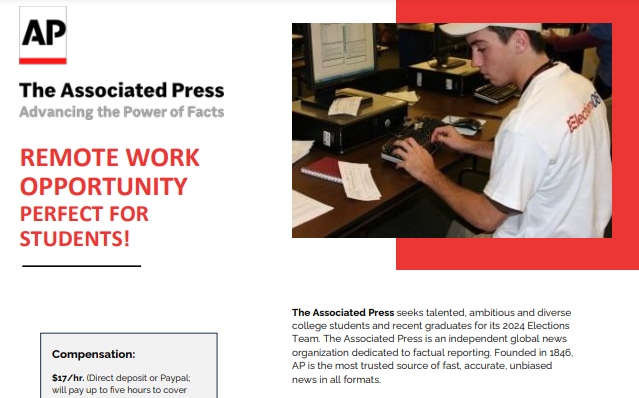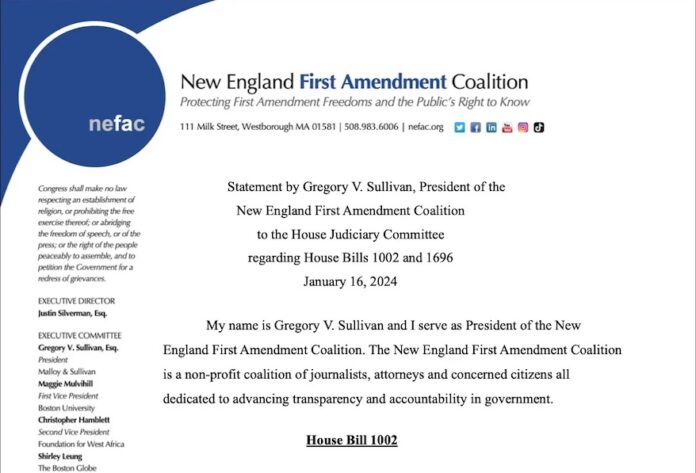 The Associated Press is offering students at universities and colleges an opportunity to pioneer the development of a Nationwide pool of special AP Vote Entry Operators working with AP to gather and report voting results from across the entire United States throughout 2024, beginning with the Super Tuesday primaries this March.
The Associated Press is offering students at universities and colleges an opportunity to pioneer the development of a Nationwide pool of special AP Vote Entry Operators working with AP to gather and report voting results from across the entire United States throughout 2024, beginning with the Super Tuesday primaries this March.
Approximately 100 students will be selected from this pool to work on the March 5 Super Tuesday primaries and paid $17.00/hour to be trained remotely in February in the use of AP’s proprietary election reporting systems and paid to work remotely with AP gathering primary election results for reporting world-wide to AP clients.
Before the 2020 election, AP worked from election centers set up in several locations around the country, but COVID issues required AP to switch to working remotely with individuals from their own homes. Now, students from across the country will be selected to comprise the first cadre of more than 500 students who will be hired to work with AP throughout 2024, covering the results of dozens of primaries across the nation and eventually election returns the night of the General Election November 5, and possibly beyond.
Participating students will be gathering the actual voting returns reported by AP news stringers from every part of the United States, helping AP inform citizens of the actual voting results, not predictions, estimates or exit polls. Participating directly in this essential civic activity is a wonderful opportunity for students to obtain first-hand knowledge of how the country’s voting system works, how news coverage of those results is managed, and also gain a valuable resume cite while being paid.
All training and work gathering election returns are performed remotely, allowing students to work in comfortable, secure environments of their choosing to ensure accurate gathering and reporting of results. AP staff emphasize that the accurate and timely gathering and reporting of election returns is the organization’s highest priority, ensuring citizens receive the most reliable results possible. Students will be working with AP professional staff and AP “stringers” who will be reporting the results directly from the more than 3,000 counties, cities and towns across the United States and its possessions.
FUNDING:
Applicants will be paid both for time spent working the election events and for time spent in remote live training sessions in the use of AP’s systems. Requirements for participation and applying for positions are on the attached flier.
Students are encouraged to participate in this essential civic responsibility while earning money for themselves.
Participants are paid $17 an hour for attending training and election night data gathering.
TO APPLY:
Have students email their contact information (name, email address, cell phone number) to VEOpool@AP.org. AP will contact them directly to determine their availability for specific training dates and to ensure they have the appropriate computer capabilities to participate.
While students can apply for participation at any time, those wishing to participate in the March Super Tuesday election coverage should submit their applications as soon as possible to give AP time to process them and include them in training sessions in February.



 The JDRF Greater New England Chapter is pleased to announce the 42nd Annual Gala–
The JDRF Greater New England Chapter is pleased to announce the 42nd Annual Gala–

 CRANSTON, RI – Primary Residential Mortgage, Inc. (PRMI) is excited to announce the addition of mortgage market leader, Juan Cerda, to their Rhode Island team of expert loan officers.
CRANSTON, RI – Primary Residential Mortgage, Inc. (PRMI) is excited to announce the addition of mortgage market leader, Juan Cerda, to their Rhode Island team of expert loan officers.
 The New England High School Journalism Collaborative is excited to announce that we will hold our all-expense-paid summer workshop for students interested in journalism for the 37th year.
The New England High School Journalism Collaborative is excited to announce that we will hold our all-expense-paid summer workshop for students interested in journalism for the 37th year.
 The tuition-free
The tuition-free 
 MANCHESTER, NH — With the turn of the year comes a fresh chance to acquire new skills at the Nackey S. Loeb School of Communications. Students will explore the art of storytelling, gain insights into media literacy, and learn more about the intricacies of effective communication in the digital age. Most classes are free and cover a range of topics, including accessing public records, mastering crisis communications to navigate challenging situations, and addressing the complex issue of hate speech in the modern world. Loeb School classes provide a platform for personal and professional growth at any age or experience level. To secure your spot, please register in advance at loebschool.org/register.
MANCHESTER, NH — With the turn of the year comes a fresh chance to acquire new skills at the Nackey S. Loeb School of Communications. Students will explore the art of storytelling, gain insights into media literacy, and learn more about the intricacies of effective communication in the digital age. Most classes are free and cover a range of topics, including accessing public records, mastering crisis communications to navigate challenging situations, and addressing the complex issue of hate speech in the modern world. Loeb School classes provide a platform for personal and professional growth at any age or experience level. To secure your spot, please register in advance at loebschool.org/register.
